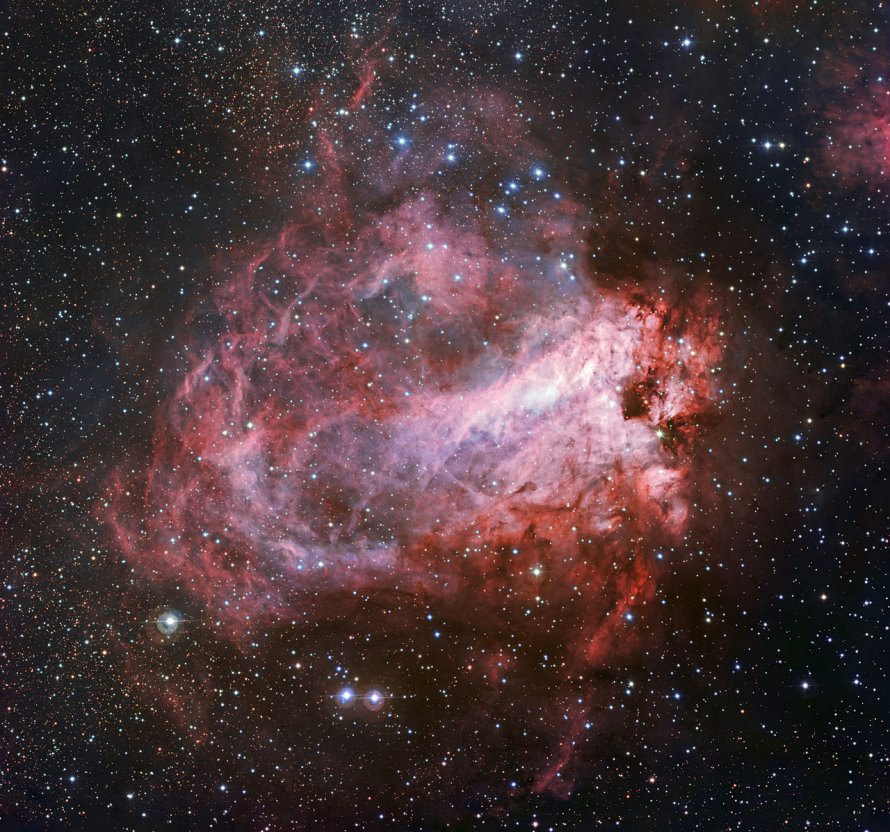M17 (NGC 6618) - Omega Nebula
Messier 17 (NGC 6618), also known as the Omega Nebula, is a diffuse nebula located in the constellation Sagittarius, in the Sagittarius Arm of the Milky Way Galaxy in the Local Group of galaxies. M17 is 5500 light years away from Earth.
M17 is best viewed during late summer, is magnitude 6, and can be viewed with naked eye (barely). M17 is 11' in apparent size. For reference, the full moon is 30'.
Observing difficulty: Intermediate
- Name:
- Omega Nebula
- Alt name:
- Swan Nebula
- Type:
- diffuse nebula
- Constellation:
- Sagittarius
- NGC or IC:
- NGC 6618
- Magnitude:
- 6
- Viewing:
- naked eye (barely)
- Size:
- 11'
- Distance (light years):
- 5500 LY
- RA:
- 18h 20.8m
- Dec:
- -16 11'
- Season:
- late summer
- Milky Way location:
- Sagittarius Arm
- Galaxy group:
- Local Group
- Messier Marathon #:
- 91
* The naked eye can see up to magnitude ~7-8 objects under ideal dark sky conditions.
The Captivating Omega Nebula
Among the deep-sky objects of the Messier catalog, Messier 17 (M17) stands out as a visually captivating and scientifically intriguing sight. Also known as the Omega Nebula or Swan Nebula, M17 is an active region of star formation located in the rich Milky Way star fields of the constellation Sagittarius. This article will dive into the features of M17, its discovery, physical characteristics, stellar population, its brightness, and guidance on how to locate and observe this fascinating nebula.
Discovery and Observation
M17 was first discovered by French astronomer Philippe Loys de Ch?seaux in 1745. Charles Messier cataloged it in 1764, but its nebulous nature was identified by William Herschel around 1784. Positioned around 5,000 light-years away from Earth, M17 appears as a faintly glowing patch to the naked eye but reveals its intricate details with the aid of a small telescope.
Physical Characteristics and Magnitude
M17 stretches over about 40 light-years, making it one of the largest HII regions known in our galaxy. The nebula's reddish hue, observed through telescopic images, originates from the excited hydrogen gas in the nebula. With an apparent magnitude of approximately 6.0, it is technically visible to the naked eye under ideal viewing conditions. However, a pair of binoculars or a small telescope will considerably enhance your ability to observe this nebula.
Stellar Composition
The heart of M17 houses an open cluster of 35 hot, young stars whose intense ultraviolet radiation causes the surrounding gas to glow, shaping the nebula. This ongoing process of star formation makes M17 an ideal laboratory for astronomers studying the birth and early evolution of stars.
Astronomical Significance
M17 holds a key position in astronomical studies due to its dynamic star-forming activity. Its complex structure, replete with cavities and pockets of gas and dust, offers a window into the early stages of stellar evolution. The diversity of stellar objects, including young O and B type stars, adds to the scientific interest in M17.
Finding and Viewing M17
Locating M17 involves finding the constellation Sagittarius, which is best viewed during the summer months from the Northern Hemisphere. M17 resides not far from the constellation's "teapot" asterism. Even through a modest telescope, M17 reveals its glowing gas and the star cluster nestled within. Larger telescopes may show its characteristic swan-like shape, with the surrounding darkness of the sky enhancing the nebula's visibility.



